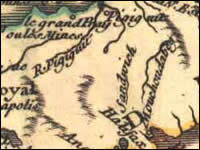


History - Pisiquit (con't)
according to Charles Morris’ observations the left
bank was the most populous, having some 800 people, next was the shores
of the Sainte-Croix River, with 500 people, and finally the right bank
was comprised of 100 occupants.
| A more detailed census of 1701 gives further information as to the standard of living at Pisiguit. Among a population of 188, there were 29 farmers with livestock; 13 farms had 11 to 25 cattle, 11 farms counted 5 to 10, and 5 farms had only 1 to 4 cattle (total cattle of Pisiguit = 283). Also, 199 arpents of land were |
|
|
cultivated and most farmers (19 out of 28) cultivated 5 to 10 arpents each. Even though there were many farmers in the village, other professions are also noted, such as coaster, tailor, ploughman, surgeon, builder, and potter. In 1710, only several churches were located in Minas Basin. The village of Pisiguit had two parishes to itself, however they were not founded at the same time. The first to be established was Sainte-Famille on August 8th 1698, on the eastern bank. Those living on the western side had to cross the river in order to attend church. Obviously, this journey was not very practical, but it wasn’t until a number of years later, on June 28th 1722, that the parish of Notre Dame de l’Assomption was founded on the opposite shore. Since only one priest was responsible for both parishes, he had to alternate sides every Sunday. During the last few years |
|
